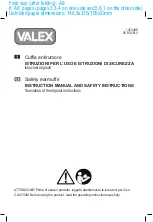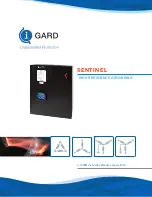
supplement to Scheme communication logic for residual
overcurrent protection ECPSCH.
To achieve fast fault clearing for all earth faults on the
line, the directional earth fault protection function can
be supported with logic that uses tele-protection
channels.
This is why the IEDs have available additions to the
scheme communication logic.
M13928-6 v2
If parallel lines are connected to common busbars at
both terminals, overreaching permissive communication
schemes can trip unselectively due to fault current
reversal. This unwanted tripping affects the healthy line
when a fault is cleared on the other line. This lack of
security can result in a total loss of interconnection
between the two buses. To avoid this type of
disturbance, a fault current reversal logic (transient
blocking logic) can be used.
M13928-8 v5
Permissive communication schemes for residual
overcurrent protection can basically operate only when
the protection in the remote IED can detect the fault.
The detection requires a sufficient minimum residual
fault current, out from this IED. The fault current can be
too low due to an opened breaker or high-positive
and/or zero-sequence source impedance behind this
IED. To overcome these conditions, weak-end infeed
(WEI) echo logic is used. The weak-end infeed echo is
limited to 200 ms to avoid channel lockup.
12. Logic
Tripping logic SMPPTRC
M12275-3 v10
A function block for protection tripping is always
provided as basic for each circuit breaker involved in the
tripping of the fault. It provides a settable pulse
prolongation to ensure a trip pulse of sufficient length,
as well as all functionality necessary for correct co-
operation with autoreclosing functions.
The trip function block also includes a settable latch
functionality for evolving faults and breaker lock-out.
Trip matrix logic TMAGAPC
M15321-3 v11
The trip matrix logic TMAGAPC function is used to route
trip signals and other logical output signals to different
output contacts on the IED.
The trip matrix logic function has 3 output signals and
these outputs can be connected to physical tripping
outputs according to the specific application needs for
settable pulse or steady output.
Group alarm logic function ALMCALH
GUID-16E60E27-F7A8-416D-8648-8174AAC49BB5 v3
The group alarm logic function ALMCALH is used to
route several alarm signals to a common indication, LED
and/or contact, in the IED.
Group warning logic function WRNCALH
GUID-F7D9A012-3AD4-4D86-BE97-DF2A99BE5383 v3
The group warning logic function WRNCALH is used to
route several warning signals to a common indication,
LED and/or contact, in the IED.
Group indication logic function INDCALH
GUID-D8D1A4EE-A87F-46C6-8529-277FC1ADA9B0 v3
The group indication logic function INDCALH is used to
route several indication signals to a common indication,
LED and/or contact, in the IED.
Basic configurable logic blocks
M11396-4 v15
The basic configurable logic blocks do not propagate
the time stamp and quality of signals (have no suffix QT
at the end of their function name). A number of logic
blocks and timers are always available as basic for the
user to adapt the configuration to the specific
application needs. The list below shows a summary of
the function blocks and their features.
These logic blocks are also available as part of an
extension logic package with the same number of
instances.
• AND function block. Each block has four inputs and
two outputs where one is inverted.
• GATE function block is used for whether or not a
signal should be able to pass from the input to the
output.
• INVERTER function block that inverts one input signal
to the output.
• LLD function block. Loop delay used to delay the
output signal one execution cycle.
• OR function block. Each block has up to six inputs and
two outputs where one is inverted.
• PULSETIMER function block can be used, for example,
for pulse extensions or limiting of operation of
outputs, settable pulse time.
• RSMEMORY function block is a flip-flop that can reset
or set an output from two inputs respectively. Each
block has two outputs where one is inverted. The
memory setting controls if, after a power interruption,
the flip-flop resets or returns to the state it had
before the power interruption. RESET input has
priority.
• SRMEMORY function block is a flip-flop that can set or
reset an output from two inputs respectively. Each
block has two outputs where one is inverted. The
memory setting controls if, after a power interruption,
1MRK 504 155-BEN F
Transformer protection RET670 2.1 IEC
ABB
39
Содержание Relion 670 series
Страница 1: ...RELION 670 SERIES Transformer protection RET670 Version 2 1 Product guide...
Страница 145: ...145...
















































